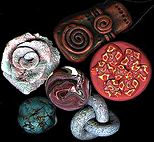|
|

 |
A few years ago, a group of friends invited me to a party. They were going to spend a few hours playing with something called "Fimo" - some sort of colored clay. "You can do really neat things with it," they said. "We'll make some beads," they said. "It's completely cool,", they said. "No, we can't explain it any better than that - you have to actually see it in action," they said.
A few hours, and I was undone. I've been addicted to the stuff since.
|
Wander through the gallery... ...and see a few of the things I've made. |
Most of my jewelry work now is done in polymer clay. I also use glass and brass beads and wire, but the clay appeals to me because of its protean quality - I can make it look like ivory or jade, like polished handworked glass, like sandstone, or like nothing ever seen on this earth before. I find something new in it every time I pick it up.
And then, of course, there's the pure childish fun of playing with it.
|
The Polymer Clay WebRing Visit the next site in the ring or visit a random site. |
Polymer clay is, as the name implies, a pliable, blendable polymer compound for artists and crafters. It's not a true clay - clay is fine particles of silicate suspended in water, whereas polymer clay is fine particles of polyvinyl chloride (PVC) suspended in plasticizer - but it can be used much like clay. Unlike earth clay, it comes in dozens of colors, and you can blend clays together like paints to make your own colors. Firing - the process that fuses the particles into a solid - requires only low temperatures, low enough to use a home oven as your kiln.
When fired, the clay gets hard enough to make durable objects, and can be finished in various ways to obtain textures from glassy to stonelike. The clay can be made to resemble turquoise, terra cotta, carved stone, marble, and semi-precious stones like jade. And since it's soft and pliable in its unfired state, it's easy to sculpt, incise, and mold it. You can make beads, buttons, game pieces, boxes, sculptures, and many other things.
Since the color is inherent in the particles, you can combine two or more colors together without blending them, if you prefer, for special effects such as Italian milefiori (originally a glasswork technique). The clay's pliability and ductility let you use techniques from woodcarving, textile arts, and sculpture. And polymer clay doesn't dry out, so you can sculpt and form it without worrying about a time limit.
|
Ways With Clay Learn new polymer clay techniques: the latest teaches how to imitate the look of stone. |
The Newbie Zone New to polymer clay? Get answers to your questions about the basics of working with polymer clay. |
Polymer Clay FAQ Interested in learning more? Here's a list of Frequently Asked Questions (and opinionated answers) about all aspects of polymer clay. |